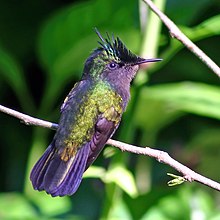Antillean crested hummingbird
| Antillean crested hummingbird | |
|---|---|

| |
| Male in Morne Diablotins National Park, Dominica | |
| Scientific classification | |
| Domain: | Eukaryota |
| Kingdom: | Animalia |
| Phylum: | Chordata |
| Class: | Aves |
| Clade: | Strisores |
| Order: | Apodiformes |
| Family: | Trochilidae |
| Tribe: | Trochilini |
| Genus: | Orthorhyncus Lacépède, 1799 |
| Species: | O. cristatus
|
| Binomial name | |
| Orthorhyncus cristatus | |

| |
| Synonyms | |
|
Trochilus cristatus Linnaeus, 1758 | |
The Antillean crested hummingbird (Orthorhyncus cristatus) is a species of
Taxonomy
In 1743 the English naturalist
Four subspecies are recognised:[7]
- O. c. exilis (Gmelin, JF 1788) – Puerto Rico south through Lesser Antilles to Saint Lucia
- O. c. ornatus Saint Vincent
- O. c. cristatus (Linnaeus, 1758) – Barbados. One study found that this subspecies showed considerable sequence divergence from the Saint Lucia and Saint Vincent subspecies. This population may have invaded Barbados from an island other than Saint Lucia or Saint Vincent, but confirmation of this possibility requires a more complete phylogeographic survey.[10] This population has been flagged as a potentially invasive species on Barbados.[11]
- O. c. emigrans Lawrence, 1877 – Grenadines and Grenada
Description
As the name implies, Antillean crested hummingbird is one of the few hummingbirds with a crest. It demonstrates the general sexual dimorphism for hummingbirds where the male is bright and colorful whilst the female is more tannish and dull.[12] Males have a short straight black bill; head with green crest, tipped metallic green to bright blue-green, upperparts dull metallic bronze-green; underparts sooty black; tail black, rounded. The female bill is similar to male’s but its head is without a crest; the forehead, crown and upperparts are metallic bronzy-green; underparts light grey; tail blackish, rounded, four outer rectrices broadly tipped whitish grey.
The subspecies can be distinguished by the colour of their crests: exilis is wholly green or slightly tinged blue on tip; ornatus has the terminal portion abruptly blue; cristatus is golden to emerald, violet terminally; emigrans is similar to the
Calls include short "tsip" or "tzip" notes and a longer series of “tslee-tslee-tslee-tslee”.[3]
Distribution and habitat
Its natural
Behavior
This species holds the first record of any avian species that became prey to an amblypygid, otherwise known as a tailless whipscorpion; it is unclear though whether or not the amblypygid caught the bird as the animal was already observed deceased.[15] The Antillean crested hummingbird had also been observed attacking the nest of a saddled anoles (Anolis stratulus).[16] The antillean crested hummingbird and many other trochilid hummingbirds display agonistic behavior towards not only other species of hummingbirds but also other noncompetitor bird species, reptiles and insects, which can have for effect to locally reduce biotic diversity and associated ecosystem services.[17]
Breeding
The Antillean crested hummingbird breeds all year round, but mainly from March–June. Its nest is cup-shaped, built on thin branches of shrub or vine 1–3 m above ground, often shaded by leaves. The nest interior is lined with soft plant fibre and the outside decorated with pieces of dead leaves, lichens, moss or bark. Clutch size is of two white eggs, size 11·6 mm × 8–8·2 mm;[18] incubation is 17–19 days done by the female who will also persistently attack intruders;[19] chicks are a darkish grey with two dorsal rows of down;[20] fledging period is about 19–21 days; young remain with female for 3–4 weeks; single brood. They first begin to breed in their second year.
Food and feeding

Its diet consists of arthropods and nectar as flowering shrubs (Lantana, Euphorbia), vines and from lower parts of hedges and large flowering trees such as the capparis tree;[19] others include Hibiscus, Bauhinia, Tabebuia, Delonix. Antillean Crested Hummingbird feed from near the ground and up to the canopy of tall trees but appear to prefer flowering plants of the understory.[19] Small arthropods may be collected from plant surfaces or hawked for in air.[3]
Conservation status
Not globally threatened (Least Concern). CITES II. Restricted-range species: present in Puerto Rico and the Virgin Islands EBA and Lesser Antilles EBA. Common resident. Particularly common at sea-level, with densities of at least 6–10 pairs/km2 on St Lucia, at least 4 to 8 pairs/km2 on Guadeloupe, and at least 3 to 5 pairs/km2 on Dominica. Widespread throughout Lesser Antilles, occurring at all altitudes and in all habitat types; ready occupation of man-made habitats suggests that habitat loss is unlikely to be a problem.[3]
References
- . Retrieved 17 November 2021.
- ^ "Appendices | CITES". cites.org. Retrieved 2022-01-14.
- ^ .
- ^ Edwards, George (1743). "The crested humming bird". A Natural History of Uncommon Birds. Vol. Part 1. London: Printed for the author at the College of Physicians. p. 37, Plate 37.
- ^ Linnaeus, Carl (1758). Systema Naturae per regna tria naturae, secundum classes, ordines, genera, species, cum characteribus, differentiis, synonymis, locis (in Latin). Vol. 1 (10th ed.). Holmiae (Stockholm): Laurentii Salvii. p. 121.
- ^ Lacépède, Bernard Germain de (1799). "Tableau des sous-classes, divisions, sous-division, ordres et genres des oiseux". Discours d'ouverture et de clôture du cours d'histoire naturelle (in French). Paris: Plassan. p. 9.
- ^ Rasmussen, Pamela, eds. (July 2021). "Hummingbirds". IOC World Bird List Version 11.2. International Ornithologists' Union. Retrieved 4 October 2020.
- ^ Peters, James Lee, ed. (1945). Check-List of Birds of the World. Vol. 5. Cambridge, Massachusetts: Harvard University Press. p. 29.
- ISBN 978-1-4081-2501-4.
- .
- Centre for Agriculture and Bioscience International. Retrieved 3 January 2021.
- JSTOR 4084604.
- S2CID 213685714.
- JSTOR 4083596.
- S2CID 86071523.
- ^ Boal, Clint (2008). "Observations of an Antillean crested hummingbird (Orthorhyncus cristatus) attacking saddled anoles (Anolis stratulus)". Journal of Caribbean Ornithology. 21 (1): 48–49.
- .
- JSTOR 4078955.
- ^ ISSN 1544-4953.
- .

